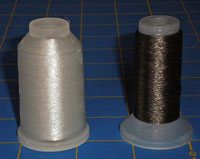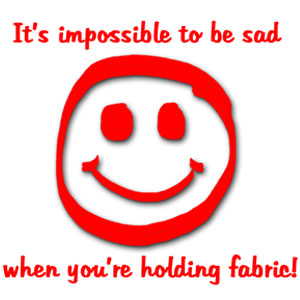- Home
- Quilting Tools/Supplies
- Clear Thread
Quilting with Clear Thread
You CAN tame the invisible thread beast
This post contains affiliate links for which I receive compensation
Clear thread (also called monofilament or invisible) is the perfect for quilting tops made with a wide range of colors, values and visual textures.

It camouflages beginning quilting stitches, creates texture from the quilting itself, all without having to change spools throughout the machine quilting process.
Without it, invisible machine applique would be, well, visible.
On this page you'll learn:
- What to look for in a quality clear thread
- Which 'color' to choose (yes, even though it's clear, it's still a color!)
- The difference between nylon and polyester fibers
- How to use it in your machine
- Fine-tuning your tension
- An alternative to monofilament if you just can't bring yourself to use it
- Brands I recommend
Choose a Quality Thread
Stick to the brand names like YLI, Superior Threads, Sulky and Madeira—you won't go wrong.
Quality invisible threads are very fine, .004mm (or .0002 inches) in diameter to be exact.
If it feels like fishing line or is bigger than .004mm, save yourself some aggravation and move on.
To evaluate any that you may already have on hand, the one you choose should:
- Feel soft and pliable, more like you hair. Soft clear threads create quilting stitches that blend into the quilt top.
- Break easily. You don't want one that has the potential to cut through the fibers of your quilt top. If it feels like fishing line, throw it out.
The Nylon vs. Polyester Question
Clear thread comes in both nylon and polyester.
Don't be confused. If your spool reads, "polyamide", it is actually nylon and not polyester. Polyamide is nylon's chemical name.
My personal favorites are both made of nylon, one made by YLI called Wonder Invisible Thread. I use them for both machine quilting and invisible machine applique. The clear threads made by Superior Threads, Sulky and Madeira are all polyester.
The argument for polyester is:
- It's not as heat sensitive as nylon
- It won't yellow
- It doesn't become brittle
I prefer clear nylon for several reasons:
- It feels softer to me than the clear polyester versions
- It looks more 'invisible' on my quilts
- I've had no problems with heat, brittleness or yellowing
- My sewing machine loves it
Now, I encourage you to make up your own mind.
If you create a lot of quilts as gifts, you have no control over how they are laundered, polyester may be a safer choice. If the quilt is displayed in direct sunlight, perhaps yellowing or brittleness may be more of a concern.
As a testament to nylon's longevity, Harriet Hargrave, the grand dame of using machine quilting to mimic the quilts of our ancestors, stands by using nylon in the needle.
She has written in several of her books that many of her quilts are over 20 years old and she is seeing no deterioration of the nylon fibers.
Clear or Smoke?
 Clear monofilament thread—Clear (l) and smoke (r)
Clear monofilament thread—Clear (l) and smoke (r)This thread comes in both clear and smoke 'colors' or tints.
For most quilting, the clear is perfect. However, if you're using a lot of toned or shaded fabrics in your quilt, do try the smoke and compare the two before deciding.
Some manufacturer's make a much darker version of smoke. It appears more like a solid color than a clear tint.
YLI makes smoke threads that virtually disappear on darker fabrics.
For other brands, if you can unwind a few inches in the store before purchasing, do so. Un-spool some and lay it on the fabric(s) intended for your quilt.
But the best test is to actually create a sample from your quilt's fabrics and stitch with your chosen color. You can make your tension adjustments at the same time.
Sewing Machine Set-up for Clear Thread
Use the smallest needle you can.
Because they are so fine and made from a single extruded fiber, monofilament threads don't relax to fill the hole left by your needle.
My preference is a size 70/10 or 65/9 Microtex Sharp needle. Many quilters have success with a Topstitching needle in these sizes.
Threading the Machine
Though a bit trickier to use, with this simple adjustments you'll be stitching in no time!
Spool or Cone?
As long as it's a quality brand, it doesn't matter if it comes on a spool, mini-cone or cone. Just be sure to thread your machine correctly.
- Straight Wind Spools For spools of monofilament, like that made by Superior, Sulky and Madeira, notice that the thread is wound straight onto the spool. It's called a 'straight wind' or 'stacked'. Spools with stacked threads work best placed on your sewing machine's vertical spool pin. The thread unwinds from the spool straight off the side without twisting. No extra tension is created.
- Cross-wound Cones Thread on cones and mini-cones is usually cross-wound. You can check by looking at the thread on the cone. Threads wound this way are made to be lifted off the top of the cone. To accomplish this, use a metal thread stand. The thread doesn't twist as it's lifted. If you try to use your horizontal spool pin, you can see how the thread is twisted when it comes off the end of the cone. This twisting creates more tension in your sewing machine. The thread strand can loop around your spool pin or uptake lever causing it to break.
Do use a metal stand (about the same price, $7-8, as a plastic one). It won't tip over or create static electricity like the plastic ones do.
Don't use your vertical spool pin for a mini-cone or cone. The pin is not designed to handle them.
If you need help taming the thread between the arm of the thread stand and your sewing machine's first thread guide, try this...
...tape a small safety pin to the right side of your machine with the 'hole' end exposed.
Run your thread through this hole to the first real thread guide.
Since the hole of the safety pin is polished, thread feeds through smoothly. This simple modification really does the job!
Suitable bobbin thread
Use a quality 100% 50 wt cotton thread like Aurifil or Masterpiece, matching the bobbin thread to the quilt backing fabric. The soft fibers of the cotton help grip the slippery clear thread making a nice, soft looking stitch.
You can use clear thread in the bobbin if you'd like.
However, because of it's inherent stretch, remember to wind the bobbin slowly.
Due to the heat produced during winding and the fact the thread is so fine, it's easy to over fill a bobbin and literally have it pop apart.
Avoid this by filling your bobbin about half full, especially if it's made of plastic.
Adjust Your Sewing Machine Tension
Quality clear thread stretches.
Prove it to yourself. Cut a length of it and give it a tug. Did you feel the stretch?
Now try it with a length of your regular cotton quilting thread. Hmmmm. No give!
Threads that stretch create their own tension as they wind through your sewing machine. To compensate for this additional tension, you must reduce the needle tension setting.
To reduce or loosen tension, remember it's 'lefty-loosey'. If tension is set with a button, decrease the number to reduce tension.
For my Viking D1, when using clear thread, I first reduce the standard machine setting by 2 numbers and then test and adjust until I'm satisfied my stitch is balanced--no needle thread showing on the back and no bobbin thread showing on the top.
That's it! You've tamed the beast!
You're ready to quilt with clear thread!
Can we talk?
A good alternative to invisible thread
Some quilters just can't bring themselves to use clear thread. For whatever reason.
If you find yourself in this group, don't worry. The good thing is that in quilting, there's always more than one way to get things done.
Consider using Wonderfil's Invisafil instead.
It's a super-fine (100 wt), 100% polyester thread. Because it's so fine it's almost, well, invisible.
Not quite.
But pretty darned close.
It comes in all sorts of colors. You can find it here.
Use a small eyed needle like a MicroTex Sharp from size 8 to 10 for best results. Use the same thread in the bobbin for the least amount of tension adjustments.
Try it and see if it meets your expectations!















